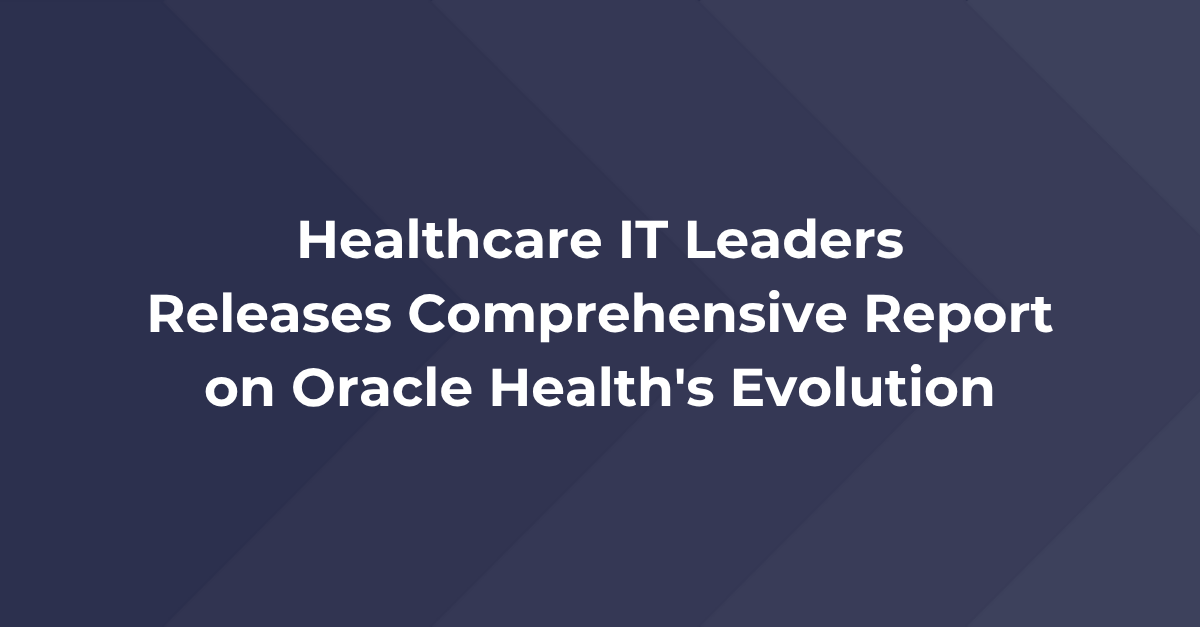Running a healthcare system with 56 hospitals, 288 clinics, and 2 million patients across 320,000 square miles is no small feat. For Sanford Health, the largest rural health system in the U.S., managing data was like herding cats—90 different electronic health records (EHRs), an overloaded SAP HANA database, and a team stretched thin trying to […]
Running a healthcare system with 56 hospitals, 288 clinics, and 2 million patients across 320,000 square miles is no small feat. For Sanford Health, the largest rural health system in the U.S., managing data was like herding cats—90 different electronic health records (EHRs), an overloaded SAP HANA database, and a team stretched thin trying to keep it all together.
For many hospital leaders, this is an everyday reality. You know it’s time to modernize, but the question is how to do it strategically—without disrupting frontline care or burning through budgets.
In a recent Healthcare IT Leaders webinar, Dane Hudelson, Senior Director of Enterprise Data & Analytics at Sanford Health, joined Conor Donnelly, our Director of Data, Cloud & AI, to share exactly how Sanford tackled this challenge. Instead of a flashy tech stack or the latest artificial intelligence (AI) trend, their journey offers a practical, proven roadmap for health systems seeking to build a smarter data strategy that supports your operational goals, drives clinical excellence, and facilitates long-term innovation.
What is a Scalable Data Strategy?
A scalable data strategy is a cross-functional blueprint that connects data goals to enterprise priorities, enables secure data sharing, and prepares organizations to adapt over time.
In practice, a well-developed data strategy includes:
- Defined governance for data access, privacy, and quality
- Modernized architecture that supports analytics and AI
- Aligned stakeholders across IT, clinical ops, and executive teams
- Phased execution tied to measurable outcomes
Think of your data strategy as your hospital’s game plan for turning messy data into something useful. It’s not just about moving stuff to the cloud or dreaming of AI-powered miracles, it’s about setting up a system that grows with you, keeps your data secure, and makes life easier for everyone—from the folks in the C-suite to the nurses on the front lines.
How Sanford Health Built Its Strategy
Sanford didn’t start by chasing tools. Instead, they started with a question: How can we build a data foundation that supports our clinical and operational future?
“There has to be a further evaluation of not just the tools,” Hudelson emphasized. “But as you get to the strategic considerations, what do we have for people and skill sets to implement those tools?”
From there, Sanford developed its data modernization strategy through a practical approach that included:
- Strategic Planning: Hudelson emphasized that the team focused first on aligning data initiatives with enterprise goals, not vendor features.
- Stakeholder Engagement: Sanford engaged leaders from IT, clinical, and business areas early in the process to gather input and ensure clear communication.
- Governance First: Before migrating anything, they established data stewardship frameworks to manage integrity, access, and compliance.
- Real-World Use Cases: Initial priorities centered on legacy system replacement and consolidating platforms with clear ROI, not just future AI opportunities.
The result? Sanford is laying the groundwork for a scalable data foundation to power AI, advanced analytics, and operational reporting—while protecting clinical workflows.
4 Pillars of a Strong Data Strategy in Healthcare
Building a data strategy that works across departments—and scales over time—requires more than good intentions. Sanford’s roadmap, backed by proven practices, points to four critical lessons that every health system should keep in mind:
1. Build Governance That Scales with Complexity
Effective governance is the backbone of any data strategy, and it ensures that as your data volumes and users grow, so does clarity, security, and accountability. For organizations looking to build strong governance, start by assigning data stewards, standardizing definitions, and establishing shared policies across departments.
2. Choose Architecture That Enables, Not Limits
Your data architecture should serve your goals, not box you in. A modern, flexible architecture (often cloud-based) can support real-time analytics, reduce silos, and prepare you for AI. Avoid vendor lock-in and prioritize systems that integrate well across your ecosystem.
3. Align Your Teams Around Shared Outcomes
The best strategies fall apart without alignment. Hospitals and health systems that succeed bring together IT, clinical operations, finance, and executive leadership early in the process. This alignment ensures buy-in and prevents misfires when strategy turns into execution.
4. Execute in Phases to Deliver Measurable Wins
Data strategies don’t succeed overnight, so think iteratively. Break the plan into phases, starting with quick wins that build confidence and trust. Mirroring Sanford’s phased execution can help demonstrate ROI while managing change with minimal disruption.
Common Pitfalls (and How to Avoid Them)
Even well-intentioned data strategies can stall when they collide with day-to-day hospital realities. Based on Sanford’s experience and lessons from dozens of health systems, here are four of the most common missteps—and how to steer around them:
- Chasing tech trends instead of defining goals first. It’s easy to be distracted by promising dashboards or AI pilots. But without a clear roadmap tied to strategic goals, even the best tools can become shelfware.
- Ignoring governance until data chaos sets in. Skipping governance early on leads to inconsistent definitions, unclear data ownership, and privacy concerns later. Governance needs to be baked into the foundation.
- Failing to involve clinicians in data decisions. Frontline staff are often the biggest users—and beneficiaries—of hospital data. Leaving them out of the strategy process can lead to poor adoption and missed value.
- Underestimating cultural change and stakeholder buy-in. Data transformation isn’t just technical—it’s behavioral. Without executive sponsorship and department-level alignment, even well-funded strategies can stall.
Avoiding these pitfalls requires a disciplined, outcome-driven approach. Before implementing anything, clarify what success looks like, who it will impact, and how change will be managed across teams.
Want to Hear the Full Story?
Sanford Health’s journey demonstrates that the path to a smarter data future isn’t paved with tools—it’s built on strategy, alignment, and trust.
If you're curious about what this looks like in action, check out our on-demand webinar, Roadmapping a Scalable Data Cloud Strategy: What Hospitals Can Learn from Sanford Health, to hear the full story on how Sanford approached data governance, executive buy-in, and phased execution, with outcomes that matter.
Ready to start mapping your own path? Whether you're just starting your modernization journey or looking to refine an existing roadmap, Healthcare IT Leaders can help. With deep healthcare expertise and a customized, outcomes-driven approach to data strategy, our experts can guide your organization through every phase of transformation—from strategic assessment to scalable execution. Contact us today, and let's get started.
TALK TO A DATA STRATEGY EXPERT
FAQs About Healthcare Data Strategy
Q: What’s the first step if we don’t have a formal data strategy?
A: Start with an assessment. Define your current state (technology, governance, people), then align stakeholders around future goals. A maturity model or roadmap exercise is a great entry point.
Q: How long does it take to implement a healthcare data strategy?
A: Timelines vary, but many systems take a phased approach over 12–24 months, beginning with governance and small pilot use cases.
Q: Do I need a specific cloud vendor to start?
A: No. The strategy should lead the tech, not the other way around. Choose tools that align with your goals and support interoperability.
Q: Who should own the data strategy within the organization?
A: Ownership varies, but success typically depends on a cross-functional team. Executive sponsorship (CIO/CDO level) is critical, but strong collaboration with clinical, operational, and data governance leaders is what brings the strategy to life.
Q: Can smaller or rural hospitals implement this type of strategy?
A: Absolutely. The scope and pace may differ, but the foundational principles—including governance, alignment, and phased execution—apply to systems of all sizes.
Q: What budget considerations should we keep in mind?
A: Budgeting should align with the phases of your strategy. Early costs often focus on planning, governance, and initial use cases, before larger platform or integration investments.
Q: How does a data strategy support AI and advanced analytics?
A: Effective AI depends on high-quality, well-governed data. A solid data strategy lays the foundation by ensuring the right architecture, definitions, access controls, and data availability.
Q: How do we know when we’re ready for cloud migration?
A: You’re ready when you’ve aligned on goals, mapped out data governance, and identified key use cases. A cloud strategy should emerge from these decisions—not precede them.



















